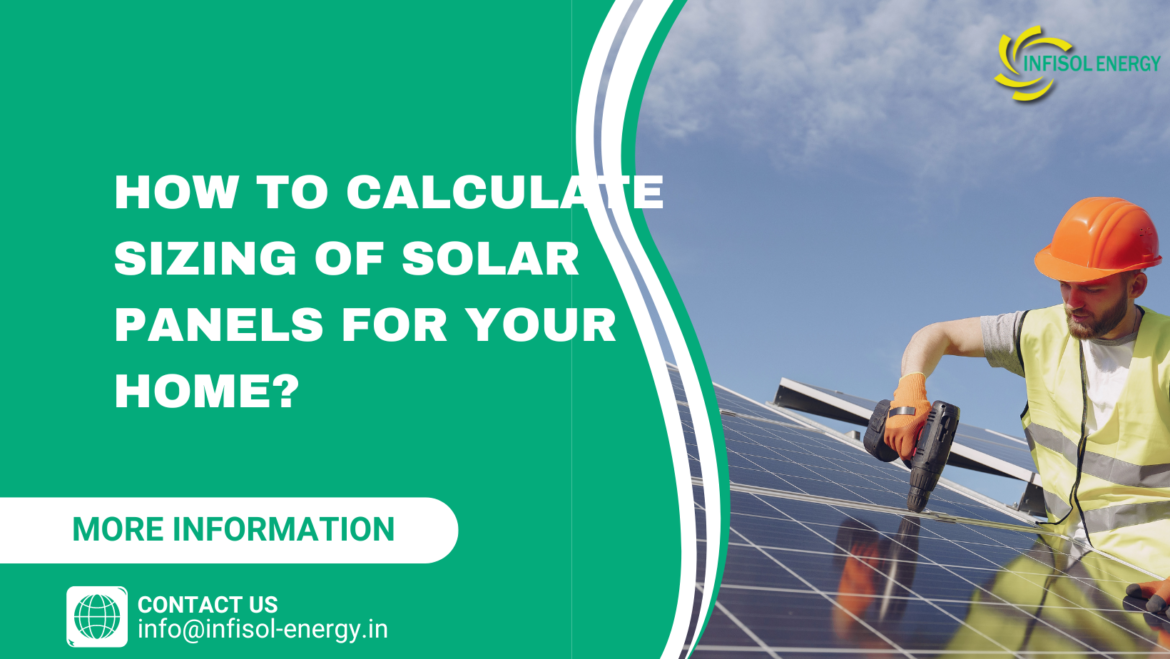Are you considering using solar energy to lower your power costs and join others in keeping the environment clean? Understanding how to measure the sizing of solar panels for your house is an important first step.
Is this a lot of information to take in at once? But don’t worry! We are here, and we shall help make it simple for you. By the end of this detailed guide, you will be able to choose PV modules, find out how many panels and inverters are needed, and optimize your solar system’s performance.
Table of Contents
Know Your Energy Needs
First things first: How much electricity do you consume? Check your utility bills over the last 12 months to determine your average monthly and annual consumption. This gives you a baseline for what capacity your solar panels need to have.
Determine Your Roof Space
Take time now and look at your roof. What amount of space can accommodate the panels? Are there any trees or other structures that may obstruct light? A roof with lots of space and no shade is ideal for getting the most solar energy.
Procedure for Sizing Solar Panels
1) Choose Photovoltaic Modules (PV)
When selecting a photovoltaic module, it must be understood that not all modules are created equal. Monocrystalline modules offer high efficiency, ranging from 19% to 20% while taking less space; hence, they are ideal if the roof area is limited.
However, polycrystalline modules are cheaper, though they show low efficiencies (16-17%), making them perfect if lots of roof space exists, resulting in reduced investment costs.
Cost-effectiveness, availability, and warranty should also come into play when choosing a PV module. Availability is crucial because even if one panel is assembled locally, its cells could be imported from another country.
2) Calculate Number Of Modules
Once you have selected the PV module, calculate how many units will be required on-site using an easy formula.
- Divide the total capacity you need (in watts) by the wattage of one panel.
For example, if you want a 10kW system and have chosen 350W panels, you would need approximately 28 panels (10,000W / 350W = 28).
3) Select an Inverter
Converters change the direct current (DC) from the solar panels into alternate (AC) power for your home. You can find two main types of inverters:
- String inverters: They are cheap and suitable for many residential systems.
- Microinverters are more expensive but offer higher efficiency, thus ideal for shading roof areas.
Choose an inverter that matches your system’s size and your budget.
4) Calculating the Number of Inverters
Calculate how many inverters you need using this formula:
- Divide the total wattage by the wattage of one inverter.
For instance, you would need four inverters for a 10kW system using 2.5kW inverters (10,000W / 2,500W = 4).
5) Find the String Size
The number of panels connected to each inverter determines string size. You will need information such as the PV module’s Voc (open-circuit voltage) and your inverter’s Mppt range. Use software designed specifically for this purpose to calculate the size of the suitable string.
6) Choose the Mounting Structure
Many important factors must be considered when choosing the mounting structure that works best with your solar panels, ensuring a high efficacy level and improving lifespan. The mounting structure supports panel placement and affects how much energy it produces. For this reason, it is important to choose a mounting structure based on:
- Roof type: The type of roof you have largely dictates which mounting structure can be used. Flat or sloped roofs have different mount options due to various limitations with building design under varying roof types.
- Snow/wind load: Snow and wind loads on panel mounts should be considered based on your location. Mounting systems in regions with heavy snowfall or strong winds need to be very strong so that the solar array’s integrity is not compromised.
- Material: The mounting structure must be strong enough to resist corrosion if you live in a coastal or humid area.
- Cost: Finally, consider the entire cost of the mounting structure, including installation. Although an expensive mount system may have a higher upfront cost, it could lead to more energy savings and last longer throughout the system’s lifetime.
Ballasted, fixed tilt, flush mount, single-axis tracking, or east-west racking are different mounting structures. Try to put them at such angles as perpendicular to sunlight during peak periods (11 AM to 3 PM).
7) Simulation
Utilize simulation software to fine-tune your design for solar panels. This process helps carry out shadow analysis and guarantees that your system is optimized for maximum efficiency.
Conclusion
You now know how to determine the size of solar panels for your house; it is time for you to start going green. We offer expert advice, custom solar solutions, and simple installations at The best solar EPC company in Pune.
We aim to help you save on energy costs and contribute to a greener future.
Contact us today for a free consultation. Let’s work together to harness the sun’s power and pave the way for a brighter, more sustainable future with solar energy.
FAQs
How do PV panels work?
Solar panels absorb sunlight and convert it into direct current (DC). An inverter converts this DC into an alternating current (AC) for home use. In an on-grid solar system any excess energy can be returned back to the grid.
How do you select a PV module?
Choose between mono and poly panels based on efficiency, cost, and space availability. Monocrystalline panels are more efficient but costlier than polycrystalline ones, which are cheaper but less efficient.
What are mono and poly solar panels?
Monocrystalline panels are made from a single silicon crystal and are more efficient. In contrast, polycrystalline ones are made from multiple silicon crystals, which makes them less efficient but more affordable.
How are modules distributed amongst the inverters in a solar system?
Divide the total number of modules by the number of inverters. During installation, adjust this distribution based on practical concerns.
Stay connected and explore our solar journey with Infisol Energy across all your favorite platforms!




